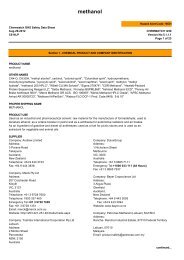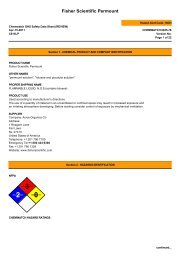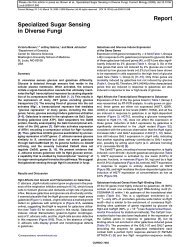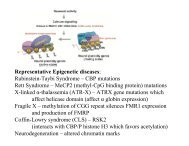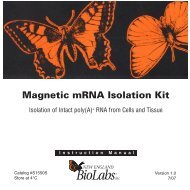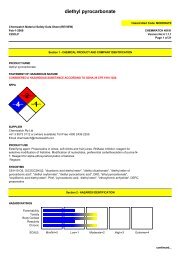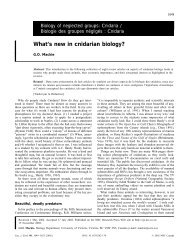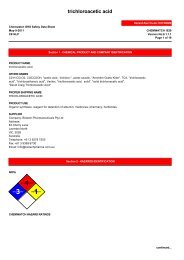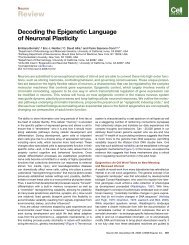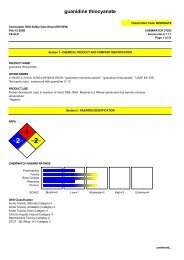Inhibition of lactate dehydrogenase A induces oxidative stress and ...
Inhibition of lactate dehydrogenase A induces oxidative stress and ...
Inhibition of lactate dehydrogenase A induces oxidative stress and ...
- No tags were found...
Create successful ePaper yourself
Turn your PDF publications into a flip-book with our unique Google optimized e-Paper software.
further slowed by FX11 (Fig. S5F). Although we noted thatsiControl cells had a modestly diminished proliferation rate ascompared with untreated cells, the siLDHA treatment remarkablydisabled cell proliferation contemporaneous with reducedLDHA expression (Fig. S6 C <strong>and</strong> D). These observations collectivelyindicate that the growth inhibitory effect <strong>of</strong> FX11 isconsistent with its ability to inhibit LDHA.We surmised that the human P493 B-lymphoma cells would besensitive to FX11 because they express LDHA (25) but that thesensitivity would be heightened under hypoxia when glycolysis isfavored. This is particularly important, because P493 cellsdepend on both glucose <strong>and</strong> glutamine metabolism when culturedat 20% (vol/vol) O 2 (26). When P493 cells were subjectedto a dose–response study with FX11, we found that growthinhibition by 9 μM FX11 was increased when the cells werecultured at 1% O 2 (Fig. S7 A <strong>and</strong> B). Hypoxia also sensitized thehuman P198 pancreatic cancer cell line to inhibition by FX11(Fig. S7 C <strong>and</strong> D), suggesting that reliance on LDHA for hypoxicmetabolism caused cancer cells to be susceptible to the growthinhibitoryeffects <strong>of</strong> LDHA inhibition by FX11.Fig. 3. (A) FK866 enhances FX11-induced loss <strong>of</strong> mitochondrial membranepotential. P493 cells treated with control vehicle, FK866, FX11, or bothinhibitors were stained with JC-1 <strong>and</strong> subjected to flow cytometric analysis,with FL2 representing red fluorescence intensity <strong>and</strong> FL1 representing greenfluorescence intensity, which is reflective <strong>of</strong> cells with decreased mitochondrialmembrane. The average percentage (±SEM) <strong>of</strong> cells with decreasedmembrane potential is indicated in each panel. The P values were 0.03,0.002, <strong>and</strong> 0.0008 when comparing FX11-treated cells, FK866-treated cells, orcells treated with both, respectively, with the control group. (B) Effect <strong>of</strong>FK866 <strong>and</strong> FX11 on P493-6 cell proliferation. Live cells were counted usingtrypan blue dye exclusion. Data are shown as the mean ± SD <strong>of</strong> triplicatesamples. (C) Effect <strong>of</strong> FX11 or FK866 on ATP levels. P493 cells were treatedwith 9 μM FX11 or 0.5 nM FK866 for 20 h <strong>and</strong> counted. ATP levels (mean ±SEM, n = 5 experiments) were determined by luciferin–luciferase-based assayon aliquots containing an equal number <strong>of</strong> live cells. *P = 0.008; **P = 0.003.(D) Immunoblot <strong>of</strong> phosphor-AMP kinase (PAMPK) in lysates <strong>of</strong> cell treatedwith FX11 or FK866. Tubulin serves as a loading control. AICAR, an AMPanalogue that activates AMPK, was used to treat the cells as a positivecontrol. (E) FX11 increases the NADH/NAD + ratio. NADH/NAD + ratio in P493cells treated with 9 μM FX11 for 24 h as compared with vehicle control.*P = 0.028. (F) FX11 inhibits <strong>lactate</strong> production. Lactate levels in the media <strong>of</strong>P493 human B cells treated with 9 μM FX11 or 0.5 nM FK866 for 24 h ascompared with control. Control RPMI contained 10.7 mmol/L glucose <strong>and</strong> nodetectable <strong>lactate</strong>. *P = 6.9E-06.We further tested whether the inhibition <strong>of</strong> human P493 Bcells by FX11 depended on glucose or on LDHA. The growth <strong>of</strong>P493 was inhibited by about 60% when depleted <strong>of</strong> glucose ascompared with growth in normal medium (Fig. S5E). Addition <strong>of</strong>FX11 could not inhibit P493 cells further in the absence <strong>of</strong>glucose, suggesting that the effect <strong>of</strong> FX11 on cell proliferationwas glucose-dependent. Furthermore, knock-down <strong>of</strong> LDHAexpression by two sequential electroporations with siRNAcaused a markedly diminished proliferative rate that was notFX11 Inhibits Tumorigenesis in Vivo. Although the renewed interestin the Warburg effect is accompanied by a greater underst<strong>and</strong>ing<strong>of</strong> its molecular underpinnings, targeting it for therapeuticalpurposes remains a major challenge (27). By characterizing asmall-molecule inhibitor <strong>of</strong> LDHA, we found that it is effectivein inhibiting cellular growth <strong>and</strong> triggering cell death by bothinducing ROS production <strong>and</strong> depleting ATP. We observed thathypoxia further sensitized human P493 lymphoma cells toLDHA inhibition by FX11. In this regard, the pervasive hypoxictumor microenvironment, as compared with normal tissues,ought to force a further dependency <strong>of</strong> these lymphoma cells onglycolysis, <strong>and</strong> particularly on LDHA (Fig. 4A <strong>and</strong> Fig. S8A). Ofnote, primary human lymphomas have been documented to haveelevated LDHA expression particularly in hypoxic regions (28).Hence, we sought to determine whether in vivo efficacy could bedemonstrated with FX11 as an inhibitor <strong>of</strong> LDHA. We calculateda desired FX11 dose <strong>of</strong> 42 μg for daily i.p. injection. Weexpected an initial serum level <strong>of</strong> ∼100 μM, assuming a uniform<strong>and</strong> immediate distribution in the vascular system withoutaccounting for the drug half-life or drug metabolism. It should benoted that solubility was a significant dose-limiting factor,because we could only double the dose further before reachingthe limited solubility <strong>of</strong> FX11 in aqueous solution.First, we sought to determine whether FX11 could inhibitP493 tumor initiation after a palpable tumor developed. Ascontrols, we injected animals with vehicle (2% (vol/vol) DMSO)or with 0.8 mg <strong>of</strong> doxycycline to inhibit MYC expression in thesetransformed human B cells. As expected, doxycycline pr<strong>of</strong>oundlyinhibited palpable tumor xenograft growth as compared withvehicle-injected control animals (Fig. 4B). Intriguingly, daily i.p.injection <strong>of</strong> 42 μg <strong>of</strong> FX11 also resulted in a remarkable inhibition<strong>of</strong> tumor growth. It is notable that we have ruled out thetrivial possibility that FX11 might directly inhibit Myc expressionto mediate this pr<strong>of</strong>ound effect (Fig. S1C). These observationsindicate that LDHA is necessary for tumor initiation.To test whether LDHA is required for tumor maintenance orprogression, we challenged the ability <strong>of</strong> FX11 to inhibit tumorxenograft growth by treating P493 lymphomas or human P198pancreatic tumors that reached the size <strong>of</strong> 200 mm 3 beforetreatment commenced. For comparison, we treated animals withvehicle control or a compound related to FX11, called E, thatlacks the benzyl group <strong>and</strong> has a K i for LDHA <strong>of</strong> >90 μM, ormore than 10-fold higher than that <strong>of</strong> FX11. We found that Ehad no antitumor activity as compared with vehicle. At thissolubility-limiting dose, FX11 displayed a static but significanteffect over 10 days (Fig. 4C). Intriguingly, we observed that thehypoxic regions associated with untreated control tumors were2040 | www.pnas.org/cgi/doi/10.1073/pnas.0914433107 Le et al.



